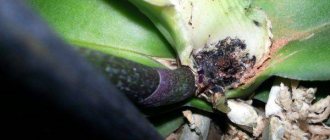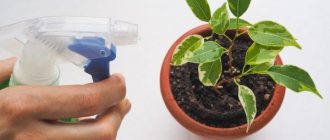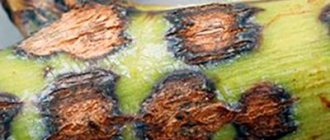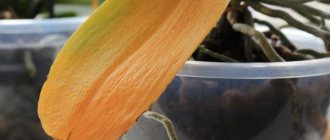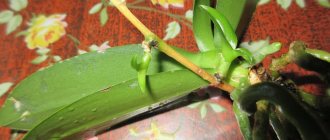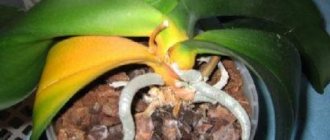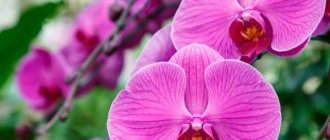Let us immediately note the fact that most species of this orchid, especially those with large beautiful flowers, are capricious, especially during the flowering period. If you do not have sufficient experience in growing tropical exotics, we recommend starting with the most unpretentious orchid, the care of which is presented in detail in the article “Dendrobium Nobile Orchid - Care and propagation at home.” Besides it, numerous Dendrobium hybrids are most adapted to living conditions in our apartments. They have similar recommendations for home care, which we will introduce you to now.
What diseases are detected in the presence of black spots and dots on orchid leaves?
Why did these symptoms appear in the plant? The cause of most orchid diseases, which are non-infectious in nature, can be safely considered to be inappropriate conditions of detention . In addition, poor care weakens the plant, causing the appearance of phytopathogens:
- Microscopic fungi. Causes damage to leaves and stems. A likely factor is low cultivation temperatures coupled with high humidity.
- Bacteria. More often they develop when any part of the orchid is injured or cause rotting due to stagnation of moisture.
- Viral diseases. Associated with the physiological characteristics of the plant.
To restore the health of an orchid, first of all, it is necessary to find out the cause of the disease and know how to eliminate it.
What to do in case of rotting?
If the roots rot, the cause may be fungi (most often they appear due to poor lighting), keeping the plant too wet, excessive use of the substrate, or pests.
If the roots are brown, feel empty to the touch, water may leak out of them, or the top layer is easily removed, all this indicates rotting.
How to treat? If the root is not entirely damaged, then the “sick” part is removed and the incision site is disinfected. If damaged at the base, it is removed completely. They are cut with a strictly disinfected instrument. If a lot of roots are removed, then the plant should be placed for a couple of minutes in a weak solution of furatsilin or manganese, then dried.
If at least one healthy root remains, then the plant is replanted , placed in a warm place in good light and cared for as if it were healthy. For an orchid to grow, a root of 5-6 centimeters is enough.
If the core of an orchid is rotting, then first you need to rule out fungal or bacterial infections. The plant is isolated from other flowers, damaged areas are removed, treated with brilliant green, then a fungicide (for fungal diseases) or a bactericide (for bacterial diseases) is used.
If the rot occurs due to moisture, it is necessary to completely cut out the rotting area, as well as the leaves (the fewer of them remain, the greater the chance of the plant to survive), disinfect the cut areas with brilliant green or activated carbon and constantly check the plant - if rot is detected again, you will have to cut the flower again .
Errors in care as a reason
Often the occurrence of orchid disease is explained by improper care .
Sun or heat burns.
Such damage to orchid leaves most often occurs due to:
- exposure to direct sunlight ;
- heat from heating radiators in winter;
- flow of hot air from the air conditioner.
This orchid condition is not a disease and therefore cannot be treated.
Insufficient lighting, low temperature, waterlogging.
A complex of unfavorable factors provoke yellowing and wilting of leaves , as well as blackening of the leaf blade due to:
- excess moisture as a result of frequent watering;
- insufficient or weak lighting ;
- hypothermia of the flower.
With short-term freezing, the orchid still has a chance to survive, but if it spent more than 11 hours in the cold , it will most likely die.
Shchitovka
This parasite looks like the tip of a match head and lives on leaves and pseudobulbs. The size of scale insects varies around 0.2 cm. The pest attaches itself tightly and for a long time to the chosen place and leaves it with great reluctance.
The scale insect feeds on plant sap and, when processing it, produces a viscous liquid. By this sign it is possible to determine the presence of a parasite on a flower. Small clusters of dark spots appear on the leaves. But even upon visual inspection, the pest itself is clearly visible on the orchid.
Infection with scale insects occurs from neighboring plants, so therapeutic and preventive measures must be applied to all plants, and not just to the sick one.
The pest settles in entire colonies and multiplies very quickly, so treatment must be carried out immediately, otherwise the parasite will spread to other flowers.
How to remove scale insects
First of all, you need to thoroughly wash the entire above-ground part of the orchid and clean the leaves, as well as the pseudobulb, from scale insects. In advanced cases, it is better to completely change the substrate. Next, you need to spray the flower with special preparations, such as Actellicom or Fitoverma. After about a week, repeat the procedure again.
After the second spraying, the soil must be completely replaced with a new one. As a preventive measure, you can wipe the orchid leaves with a damp cloth or sponge every 4-5 days, and also spill the substrate with a large amount of boiled water every 20-30 days.
How to normalize care?
The conditions for keeping the flower are as close to natural as possible, alternating abundant watering with warm water and drying out the substrate. Good soil drying is ensured by:
- free air circulation ;
- regular ventilation .
In the room where the orchids are located, drafts must be excluded .
When determining the frequency and abundance of watering, take into account:
- pot volume;
- room temperature;
- substrate density.
Attention! The watering regime for orchids is set based on the condition of the soil in the pot, and not on the period of time after which watering is carried out.
An orchid that has black spots due to improper care is rearranged:
- to diffuse sunlight . In the autumn-winter period, additional lighting may be needed;
- summer daytime air temperature in the apartment should be from 15 to 30℃ , in winter – 20-23℃ . Daily fluctuations in day and night temperatures are within 3-5 ℃;
- The ambient humidity is at least 50 , and for some types of orchids (Vanda) - more than 60%.
In favorable conditions, the flower will be able to recover as quickly as possible.
Features of Dendrobium transplantation
Dendrobiums are transplanted no more often than once every two to four years, since they do not like this procedure. You need a good reason for this, such as:
- pieces of bark in the substrate turned into dust;
- the root system has filled the entire planting container, displacing the substrate, and now it is clearly not enough to support the plant;
- roots stick out above the surface of the substrate;
- due to the tightness of the pot, the flower stopped growing;
- a coating of salty soil appeared on the roots.
This may be interesting: Wanda - caring for a royal orchid at home
Dendrobium should be replanted in the spring, when the plant is just emerging from dormancy and is preparing for active growth. We do not recommend replanting during flowering. But, if there is a suspicion of rotting of the root system, there is no need to wait for favorable conditions, urgently start replanting.
Soil for replanting
A special substrate for Dendrobium is prepared or purchased, different from the substrate for other indoor flowers. It is more loose, lightweight, moisture-permeable and breathable. It consists of large pieces (1-3 cm) of pine bark (2 hours), large expanded clay (1 hour), charcoal (1 hour). Sometimes, pieces of sphagnum moss are added here. But not much, so that excess moisture does not cause rotting of the roots. The substrate performs more of a function of fixing the roots than feeding the flower. Expanded clay and coal accumulate moisture during watering, and then gradually release it to the bark. Coal is also needed to prevent fungal diseases and fight mold that may appear in pieces of pine bark. If you prepare the substrate yourself, take the time to disinfect all components of the soil mixture. Boil the bark a couple of times, then dry it well. If you buy a ready-made substrate for epiphytic or orchids, you will not go wrong.
Pot for Dendrobium
Prepare a ceramic or plastic pot for transplanting Dendrobium, slightly larger than the root ball. Not necessarily transparent - these are needed only for Phalaenopsis. Dendrobiums in transparent pots have roots that overheat. Be sure to lay a good drainage layer at the bottom of the pot from the largest pieces of bark or expanded clay.
Dendrobium orchid transplant process
Now proceed to transplanting the plant itself.
Remove it from the pot. Free the roots from the substrate and inspect them. Trim those that are damaged, rotten or too long. Sprinkle the cuts with crushed coal. Let them dry a little. After this, place the bush in a new pot on a layer of drainage. Cover the roots with substrate so that there are no voids between the roots. Water it. It is advisable that two to three cm from the top of the pot to the base of the rosette remain free. Then, as the aerial roots grow, there will be room in the pot to add substrate. A large specimen of the Dendrobium orchid with fleshy, heavy leaves needs to be strengthened in the substrate. During replanting, we recommend installing a support in the pot and immediately tying the flower to it so that it does not wobble.
After transplantation, it will take a couple of weeks until the flower regains its strength. At this time he needs help. Place the pot in a bright, warm place with high humidity, but in partial shade. If the interference in the root system of the plant was noticeable, we recommend placing the transplanted plant in a large plastic bag to create a greenhouse effect - it will be easier for Dendrobium to recover. For a couple of weeks. Look into the bag and ventilate it if necessary. If the flower looks strong and cheerful, take it out of the bag and put it in its rightful place - let it grow with renewed vigor.
Plant diseases as the cause of the problem
A weakened plant is easily susceptible to various diseases.
Fungal diseases
Successful treatment of orchids is impossible without identifying the causative agent of the disease. Among the fungal phytopathogens, the most common are:
- Anthracosis. The disease is favored by conditions of excess humidity and water stagnation in leaf axils. It manifests itself in a rapid increase in black spots on the leaves already at the initial stages, individual dark spots gradually merge into spots;
- Phyllosticosis . The disease appears as yellow and black dots on the leaves , the size of which remains constant for 2-3 months. During this latent period, the fungus rapidly develops inside the tissues. The disease affects the entire leaf blade and causes its death;
- Late blight . The most dangerous fungal disease of orchids. Characterized by the appearance of purple spots , which then spread, turn black and can cause the death of the plant. Black sunken spots often appear where the leaf meets the stem, and the affected area crumbles, leaving a black mesh.
The disease occurs due to excessive watering or high soil density.
Treatment of fungal diseases involves immediate removal of stains with a sterile instrument , disinfection of sections, and treatment of the entire plant with a fungicide. Then the orchid is moved to diffused light in a well-ventilated place.
Viral diseases
Orchids are rarely affected by viruses . The disease most often manifests itself on leaves as mosaic spotting .
The nature of the disease is influenced by the structure of the leaves (thickness, fleshiness). of small light spots in the initial phase is typical ; over time, they darken and are pressed through. Sometimes the middle of the black ring remains green. Affected plants are destroyed.
Bacterial lesions
The most common bacterial diseases of orchids are:
- bacterial rot. It appears as brown spots on the leaf blades; over time they grow and darken. The disease spreads to the remaining parts of the plant until it completely captures them;
- bacterial spot. A characteristic feature is dark spots framed by a light rim.
In the initial phase of the disease, all spots are carefully cut out along with part of the healthy tissue . If the lesion covers a large area of the leaf, it is completely removed. Sections are disinfected with brilliant green or iodine. After the procedure, watering the orchid should be moderate.
Thrips
These are small insects up to 2.5 mm in size. The activity of the pest has an extremely negative effect on all types of orchids and Dendrobium in particular. The insect has a pair of wings that fold on the back and is characterized by increased activity: it moves quickly and hides skillfully.
As soon as the pest hits the flower, it tries to hide in the ground. To detect the presence of thrips visually, you have to watch the plant at night with a flashlight. If you suddenly turn on the light, the insect will immediately reveal itself. Indirect indicators of the presence of the parasite are a silvery film and black dots on the greenery.
The consequences of prolonged stay of thrips on the orchid are numerous brown spots. This indicates the appearance of larvae and that you need to start fighting the parasite immediately.
The difficulty in controlling thrips lies in its persistence. They lay tiny and well-protected eggs in leaf tissue. After the larvae hatch, they feed on these greens, moving from place to place.
The pest subsequently affects not only the foliage, but also affects the root system, which leads to the death of the flower.
Treatment of orchids for thrips
An orchid must be isolated from other plants. First of all, it is necessary to completely replace the soil. To combat thrips, the drugs “Fitoverm” and “Actellik” are suitable. It is necessary to spray the plant the last 2-3 times and repeat the procedure after 10 days.
As a preventive measure, it is worth thoroughly treating the leaves with warm water every 5 days. The new substrate must be watered generously about once a month.
What to do if black spots appear at the base of the leaf?
Most often, their occurrence is associated with infection of the plant by phytopathogens , and not due to ordinary rotting from stagnant water:
- to prevent the spread of the disease, the damaged area is removed , partially capturing healthy green tissue;
- sections are disinfected with iodine , brilliant green, and crushed charcoal.
To eliminate stagnant water that accumulates in the axils of the leaves after watering, remove it with a paper napkin .
Treatment Options
From the moment an orchid is infected until the first symptoms of the disease appear, a certain amount of time passes, different for individual species - from 3 to 6 weeks. Immediately after the disease manifests itself, the infected plant is isolated from other house flowers, and the window sill where it stood is thoroughly washed with water containing hydrogen peroxide or bleach diluted in it.
The affected areas are cut off to healthy tissue, and the cut areas are treated with brilliant green or sprinkled with cinnamon or powdered charcoal. Tools must be thoroughly disinfected with alcohol or heated over a flame so as not to spread spores to all home flowers, and hands must be washed well with soap. The plant should then be treated with one of the fungicides, such as kresoxim-methyl, bromuconazole or mancozeb. For small lesions, you can use copper-based preparations - Bordeaux mixture, copper oxychloride, copper sulfate and others.
In addition to drastic means, in the fight against phyllosticosis, one should not forget about optimizing housing conditions, since even effective fungicides will not help save a plant that has not been moved from a semi-shaded place to a more illuminated one. Orchids of the genera Vanda and Cymbidium are difficult to treat because, due to the structure of the leaves, the disease may not manifest itself for more than 12 months. However, plants with a spot that appears harmless at first glance and does not change for a long time can turn out to be a real disaster for other orchids in the neighborhood.
If the tips of the leaves begin to turn black?
To stop the spread of the disease:
- if possible, establish the nature of the disease ;
- blackened areas are trimmed with sterile scissors ;
- provide optimal care and maintenance of the orchid.
If the disease is infectious, the plant is isolated and, if necessary, treated with a fungicide.
Whitefly
It is a tiny and cute looking butterfly that is white in color. But you can’t call her harmless. The pest itself and its larvae suck the juices out of the orchid. As a result, the leaves turn yellow and the plant begins to wither. A butterfly can hide anywhere, even in the bark.
Trying to catch it manually is quite problematic. She is very nimble and when you touch a flower she immediately takes off. Eggs with larvae are located in a good half of cases under the bark and leaves.
How to get rid of a pest
Regular laundry soap acts as a remedy. To prepare the solution, you need to dilute it with water in a ratio of 1 to 6. If we are talking about a single orchid, and not a group, then you can simply rub a napkin or sponge with soap and wipe each leaf.
If the pest has spread throughout the plant, then both the orchid and the substrate must be treated with Actellik or an analogue.
The flower definitely needs prevention. Approximately once every 5 days, the entire above-ground part must be washed and wiped, and the substrate must be shed generously once a month.
Reproduction
Propagation of the Dedrobium orchid is possible by cuttings on which the children grow, or by dividing the bush, the first is used more often.
Propagation of dendrobium orchid by cuttings
1. When transplanting, cut old shoots into cuttings with two or three internodes;
2. Place them in a container with damp moss;
3. Cover the top with polyethylene;
4. Place in a room with diffused light at a temperature of 22-26 degrees;
5. When young shoots appear in the nodes, they need to be carefully cut off and transplanted into a prepared container.
Reproduction by dividing the bush
- Performed during transplantation (every 3-4 years) if there are 6-8 pseudobulbs (pseudo-tubers);
- The root is cleared of soil;
- The bush is cut into pieces using a knife. Each should have a root, a shoot and several pseudobulbs;
- All sections are treated with ash or potassium permanganate;
- Parts of the bush are planted in different pots.
Questions and answers
Dendrobium refuses to bloom?
It is necessary to pay attention to the general condition of the flower. If the orchid looks healthy, then the reason is lack of light. The plant is moved to a sunnier place or given additional light. When a flower looks too weakened, it is not provided with proper care. It is necessary to adjust the temperature, humidity, and fertilizing schedule.
Do dendrobiums need to be fertilized after flowering?
Nitrogen fertilizing will definitely benefit the plant. It is especially good to fertilize specimens on which new shoots have begun to appear. Thanks to nitrogen, they will begin to actively develop.
When does an orchid have a dormant period?
In most varieties of dendrobium, flowering occurs in February-May, and a set of green mass occurs in March-April. The plant enters the dormant phase from May to September. It should be borne in mind that not all varieties are the same, so you need to study the characteristics of a particular variety.
Is it possible to replant Dendrobium during flowering?
Transplantation occurs only after flowering.
Rate this post
More about the flower
Orchids of the genus Dendrobium form new rosettes at the base of the old one on the rhizome, that is, they are representatives of the sympodial type. The shoots of young specimens are erect, but become lodging with age. Leaves are linear or elliptical. The pseudobulbs on which the buds form can grow up to half a meter, and when they die, they become bare and produce daughter rosettes.



